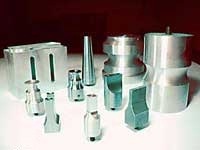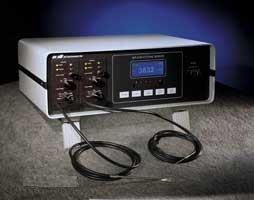Ultrasonics is defined as vibrations of frequencies greater than the upper limit of the audible range for the human ear. This technique is used in everyday products for assembly purposes. In fact, a unique process called ultrasonic welding is used to make products such as bags, packages, plastic toys, diapers, etc.
Energy is produced when a part is agitated at a frequency. The amount of energy produced is directly proportional to the amplitude and frequency at which the part shifts. In other words, when the frequency and amplitude are higher, the energy produced is also higher. In order to produce this motion an electrical signal of high voltage and high frequency is passed to a piezo-electric crystal stack.
Upon agitating the crystals, they contract and expand at the same speed as the excitation signal. The peak-to-peak travel distance or amplitude relies on the length of the piezo stack and the applied voltage. Average frequencies range between 20 and 60kHz with amplitudes ranging from 2.5µm to more than 50µm.
Ultrasonic Horn
An ultrasonic horn, also known as acoustic horn, is a device that is used to concentrate this energy and apply it to a process. This device is available in a variety of configurations and sizes depending on the application for which they are developed.

Figure 1. Different horn configurations
Figure 1 displays different horn configurations. When the horn’s tip is made to contact a component at a specific pressure, frictional heat is produced which in turn makes the material to plasticize locally and generates an insoluble link between two parts in a matter of time. When the energy is removed, the part cures and produces the bond. Figure 2 shows the seam of a plastic bag, which is a classic case of a typical bond.

Figure 2. Seam of a plastic bag
Horn Frequency and Amplitude
To produce a reliable weld or bond, the ultrasonic horn must be able to generate a specific amount of homogeneous energy. When frequency or the energy distribution across a horn’s face varies, it will result in an unreliable process. Therefore, the operator must accurately control the horn’s motion characteristics to sustain integrity and consistency of the product. Also, horn amplitude and frequency need to be measured periodically.
Non-contact Vibration Sensor
In order to address this issue, MTI Instruments has designed an advanced non-contact fiber optic vibration sensor called MTI-2100 Fotonic sensor (Figure 3). This device uses sophisticated electronic and fiber optic technologies to enable accurate measurements of vibration, position and displacement.

Figure 3. MTI-2100 Fotonic sensor
Since the senor is non-contact in nature, it does not reduce the vibration amplitude or impact the target motion. A fiber optic probe features a range of fibers that receive and transmit light. These fibers are available in various configurations. With the help of a tungsten halogen lamp, light is fed into the transmit fibers, from there it exits the probe tip and strikes the ultrasonic horn.
The receive fibers in turn captures the light reflected from the horn and transmits it to the MTI-2100 Fotonic sensor. The intensity of the light was observed and found to be relative to the distance between the target being measured and the probe tip.
With the help of the LCD display, peak-to-peak amplitude measurements of the horn is obtained in metric and English units, while output waveform data in real time was provided by a rear panel BNC connector. This waveform can be examined to ascertain amplitude, frequency, and consistency and integrity of the horn output. This can be useful for studying novel horn designs and also for identifying horn defects.
Customized Sensor Solutions
MTI Instruments supplies the MTI-2100 Fotonic sensor mainframe in an extensive range of interchangeable probe modules to allow excellent application flexibility. The MTI-2062R is a general-purpose probe module that provides 150kHz frequency response, 2.5nm output resolution, and 1.2mm target footprint.
In case of horn applications where the tip of the horn is either tapered or thin, MTI provides a special “Edge” probe that produces light, which is projected onto the tip. When vibration takes place, the proportion of light received modulates and this modulation is changed into a peak-to-peak displacement by the MTI-2100 sensor
Conclusion
The MTI-2100 Fotonic sensor allows ultrasonic equipment manufacturers to perform accurate and repeatable measurements of vibration. For challenging applications, MTI Instruments has a team of application specialists who assess specific requirements and provide a viable and cost-effective solution.
About MTI Instruments
MTI Instruments is a worldwide leader in the design, manufacture and engineering of non-contact measurement systems and sensors.
MTII’s main products consist of computerized general gauging instruments for position, displacement, thickness and vibration applications based on laser triangulation, fiber-optic and capacitance measurement technologies.
The Semiconductor Products sensor group manufactures manual, semi-automated and fully automated wafer characterization tools designed to measure wafer thickness, total thickness variation (TTV), bow, warp and flatness of semi-insulating and semiconducting materials.
MTII’s Aviation Balancing Instruments group provides state-of-the-art portable balancing and vibration analysis systems for turboprop and jet aircraft engines.

This information has been sourced, reviewed and adapted from materials provided by MTI Instruments.
For more information on this source, please visit MTI Instruments.